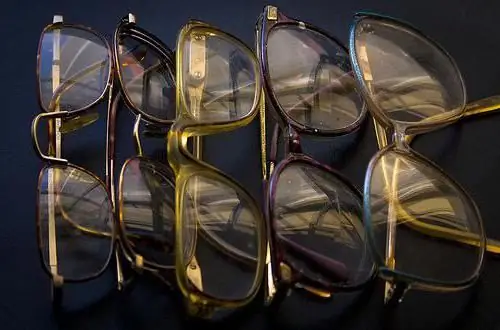2026 Author: Priscilla Miln | [email protected]. Last modified: 2025-01-22 17:55:18
Since the 1950s, faceted glass has become one of the main "folk" symbols of the Soviet Union, and after its collapse - the subject of endless nostalgia. However, it has not lost its practical application: as an indispensable companion of small and large feasts and as a measuring container, which is always at hand. Faceted glasses are universal products. With a thick trail of legends following them. Let's try to figure out what is true in the history of granchak, and what is beautiful, but a fairy tale.

Definitely a legend - the story of a gift from the famous Vladimir glassblower Efim Smolin to Tsar Peter I. Take Granchak and shatter into pieces. But the glassblower swore that he did not beat! However, everything worked out. Since the retinue "translated" the king's words - "beat glasses!", Hence, they say, the custom began after drinking to break dishes for good luck. Samples of glassware of the 17th century, includingand faceted glasses are now kept in the Hermitage. And it's not a legend.

It can also be considered a legend that the authorship of the Soviet faceted glass belongs to the famous sculptor, the creator of the world-famous monument "Worker and Collective Farm Girl" Vera Mukhina. Moreover, in collaboration with the avant-garde artist Kazimir Malevich. The latter died in 1935. Mukhina came to grips with glass only in the late 1940s. True, the task also belongs to this time: to create a sufficiently durable glass for catering needs that would withstand the process of washing in a dishwasher. Another legend is the day the first glass with edges was made, from which all Soviet faceted glasses: September 11, 1943. At that time, the famous plant in Gus-Khrustalny, where this allegedly happened, was engaged in the production of exclusively military medical products: thermometers, flasks, flasks, etc.

At least three common expressions are associated with granczak. "Simple as three pennies" - this is how much the product cost at the dawn of its existence. "Seven kopecks", i.e. nowhere more primitive, - reflects the price of a faceted glass in the 1970s-1980s. Finally, the legendary "let's figure it out for three?" In the early 1960s, the government, fighting drunkenness, laid a strong hand on the retail trade in alcohol, forbidding the sale of vodka on tap and removing 125-gram scoundrels and half-large checks from the assortment. A standard half-litre cost 2 rubles 87kopecks. It was believed that every hard worker had a ruble for lunch with him. "For three" there was enough money, and each faceted glass contained enough grams.
The classic faceted glass is 110 mm in height, its bottom diameter is 65 mm, along the "throat" - 75 mm. The number of faces is 16 (a 20-sided glass cost 14 kopecks). Volume - 200 cubic meters. see. If you pour it along the rim, 200 ml comes out, if to the brim - 250 ml. But milk it includes 204 ml, sour cream - 210 ml. Sugar in a faceted glass, if to the brim, weighs 200 grams. It can also hold 9 egg whites or 10 yolks. Finally, a "glass of seeds" without containers weighs 90 grams. And if they are cleaned - 58. In the 80s, a disaster happened: a real epidemic of granchak explosions swept across the country. The resonance was not weak: there were articles in the press, a story in the satirical newsreel "Wick". Finally, the party, sensing ideological sabotage (the whole country was drinking!), instructed the competent authorities to sort it out. Soon they reported: it was all the fault of a small change in technology that had to be made due to the introduction of imported lines at glass factories. As a result of a change in the structure of glass, faceted glasses acquired the property of literally crumbling from loud sounds. By the way, this episode is shown at the very beginning of the famous series "The Brigade".
Recommended:
How to get rid of the smell of dog urine: the use of professional household chemicals, folk methods and home remedies

How to get rid of the smell of dog urine? Which is better to use, chlorine-based products, regular floor cleaners, or special solutions from a pet store? Are folk remedies able to solve this problem?
Square men's glasses: types of glasses, purpose, frame material, combinations with the shape of the face and appearance with a photo

Glasses have long ceased to be a device that helps only improve vision. In addition to their direct purpose, they are used to change the image, to hide the eyes from exposure to bright sunlight or to protect against ultraviolet radiation, which a person succumbs to when working with a computer or tablet. Today we will talk about what type of appearance square men's glasses are suitable for and what types they are
Household utensils: examples, purpose. household items

To provide yourself with everything you need and make life more comfortable, and daily work easier to perform, a person surrounds himself with a wide variety of useful household items. Household utensils are the lion's share of all movable property of each of us, although different people may include different things in the list of this very utensil
Is the faceted glass a symbol of Russia?

Where the faceted glass came from is not known for certain. There are several versions of this. According to one of them, this piece of tableware began to be made in Russia back in the time of Peter the Great. Allegedly, the glassmaker Efim Smolin from the glorious city of Vladimir presented his invention to the autocrat, assuring the emperor that the faceted glass does not break
Corrective glasses - what is it? Corrective glasses: general characteristics, description, varieties, photos

Visual impairment has become common today. However, there are optical devices that can solve this problem. Corrective glasses help to see how a he althy person is. What it is? These are special products used for both refraction and accommodation

